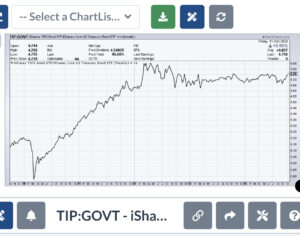Why you don’t need TIPS
My last post lampooned the universal practice of confusing the CPI with inflation. Now let’s look at just one of the ramifications for investors.
TIPS – Treasury Inflation Protected Securities – remain a widely recommended asset class for investors concerned about protecting their portfolios from the ravages of inflation. Financology has previously criticized such recommendations on the same grounds – they are indexed to the CPI, not to inflation – and therefore their very name is a case of false advertising. Just one of multiple faults addressed in I Don’t Like TIPS.
This however hardly assuages the need for investors to have inflation protection. And our previous post, however long on criticism, fell short on solutions. Here let’s take a look at how investors that might otherwise be tempted by TIPS can do better.
In short, there’s nothing TIPS can do for you that other assets can’t do better. Investors that want assets denominated in dollars – those whose return is promised in terms of dollars – want bills, notes and bonds. Treasuries for instance. Those that don’t … well why would they look to fixed income in the first place … don’t. They want stocks, commodities, real estate, collectibles, etc.
TIPS seem to offer a way to have your cake and eat it. And for an investor that’s only going to own one asset, they might make sense. But just one asset always embeds more risk than any investor should seek to or need to bear. Owning only the obligations of one issuer, including the US government, is putting all of one’s eggs in one basket.
This already hints at the superior alternative. Own nominal dollar-denominated assets for nominal dollar protection and non-dollar-denominated assets for non-dollar-denominated protection. This way you know exactly how much you’ve devoted to each and can calibrate it to your investment priories and outlook.
It also avoids the risk of depending on the government to honestly compensate you for inflation, a fox guarding the henhouse kind of thing, instead harnessing the power of markets.
The following chart helps visualize how TIPS themselves behave like a mix of ordinary treasuries and other assets. A recent example highlighting this was in 2020. Recall that the pandemic crisis triggered a deflationary crash. I’ve plotted the performance of TIPS, ordinary treasuries, commodities and stocks using the ETFs TIP, GOVT, COMT and VT respectively as representatives of each asset class.

Notice that in this deflationary squall TIPS endured a mini-crash not unlike commodities (COMT) and stocks (VT). Meanwhile plain vanilla treasuries (GOVT) experienced mere ripples in comparison. The take home from this is simple … there was no free lunch … whatever inflation protection you may have bought with TIPS was paid for with deflation risk. You may as well have just owned a mix of vanilla treasuries, commodities and stocks.
You would have also earned better returns for each unit of risk. Why? Over time, inflation reflected in the CPI is less than that recorded by corporate earnings and commodity prices. Market-based inflation protection.
This next chart from StockCharts better emphasizes the performance of TIPS relative to regular Treasuries, via TIP:GOVT. We see again how TIPS crashed along with stocks in the 2020 deflation. Then how they outperformed – along with stocks – through 2021. We also see how they underperformed ordinary Treasuries in disinflationary 2022, again, right along with stocks. In other words, TIPS acted like a mix of treasuries and equities.

Wait … Finster??? Did you just say “disinflationary 2022”? Wasn’t that when inflation was rocketing higher?
No!!! That’s when the CPI was rocketing higher. As I have been saying, CPI does not equal inflation, and I don’t mean just in magnitude. Consumer prices lag in time too. In fact it’s striking that even TIPS, keyed to the CPI, registered disinflation in 2022 right along with stocks – when it was happening – not in 2023 when it was finally making its way into the CPI.
Rising consumer prices aren’t inflation; they’re its exhaust fumes.
In sum, for those of us seeking protection from inflation, the better option is to simply own less treasuries and more stocks and commodities than we would have otherwise. The more appropriate target audience for TIPS would be those investors who for regulatory or other reasons must own a certain allocation to treasuries or have CPI-indexed obligations, usually pension funds and other institutional investors.
A practical example of this is on the Financology Model Portfolio page. The last MP listed, the 18:18:32:32 Portfolio, includes an 18% allocation to what might have been TIPS. It’s constructed of a mix of two of the ETFs listed above, GOVT for vanilla treasuries and COMT for commodities. We could have gone further and mixed in some IAU for gold and VT for stocks, but the portfolio already had dedicated allocations for those. Unlike a TIPS allocation though, this one doesn’t invoke the CPI=inflation fallacy and is tweakable to reflect whatever inflation protection is desired.